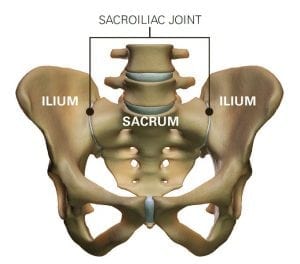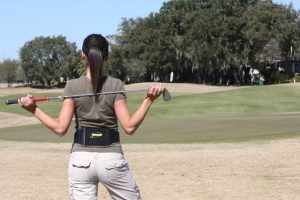We’re calling it – the weather is on the turn and summer will soon be here! For many of us, this means a return to our favourite sports and activities (or at least the chance to get outside of the sports hall for a bit!). On that note – how would you feel about shaving a few minutes off your best time, beating your personal best, or taking a couple of stokes of your game this year? If that answer to that was yes, Chiropractic can help!
Running can be a real pain in the…hip?
While we often associate running injuries with ankle strains, trips or falls, hip problems are another common issue among runners – especially those of us who are slightly older! The sacroiliac (SI) joints are the normal source of hip pain. They connect the sacrum (the triangular bone at the base of the spine) with the pelvic bones (iliac bones). As you might imagine, this joint play a key role in stabilisation of the spine and the hips, especially during running. If movement within the joint becomes too restricted, or too loose -it can result in sacroiliac joint dysfunction. Thankfully, chiropractic care has been highly successful in treating SI joint dysfunction.
For instance, in a recent case of a 32-year old male marathon runner, who ran approximately 100 to 150 kilometres per week for three years, SJ pain stopped him dead in his tracks. But just a month after completing two weeks of chiropractic care, he was pain-free with the option to slowly work back into the marathon running.[1]
Since most sports include some form of running – this is one to really consider.
Chiropractic supports track and field
For years, chiropractors have worked with world-class Olympic athletes to improve their strength, endurance, and range of motion while training, in almost every track and field discipline, it’s now normal for athletes to have chiropractic are on hand. This isn’t just true of “regular” athletes either – many Paralympians rely on chiropractic care to give them the edge.[2]
It Soothes Tennis Elbow
We often don’t think of tennis as a “high injury“sport – but the fact is as much as 50 per cent of tennis players can expect to get tennis elbow during their lifetime, and one-third of tennis players will experience it in severe fashion – it’s not just a painful condition, during severe episodes it can be life limiting. The main goals of chiropractic therapy for tennis elbow is to relieve discomfort and redness, promote healing, rehabilitate the injured arm, and avoid recurrence.[3] Specific joint manipulation performed by a chiropractor has shown to be effective for discomfort associated with tennis elbow and to promote long term health and healing.
Chiropractic is Helpful for Hockey Injuries
Whether you prefer the ice variety or the more traditional one hockey is a taxing sport in which injuries are common. Chiropractic has been shown to reduce painful symptoms of recurrent shoulder instability related to hockey injuries.[4]
An effective way to reduce Sports Hernia
Between Five and twenty per cent of all sports injuries involve groin pain – which can be a real pain in the…well, groin! One of the most common causes of groin pain in athletes is athletic pubalgia, commonly referred to as sports hernia.[5] A recent study of footballers, who seem to be at especially high risk, showed a significant reduction in discomfort 8 weeks of a combination therapy that consisted of chiropractic care and rehabilitation exercises.[6]
Chiropractic improves grip strength in martial artists
A recent study involving 18 professional Brazilian judo athletes explored the benefits which chiropractic care could provide. Half received chiropractic adjustments to their cervical spine, the other half received a placebo treatment. Researchers examined the effect of the treatment by evaluating the athletes’ grip strength because judo relies heavily on muscle forces in the hands and arms.
The researchers measured grip strength before and after each cervical spinal manipulation. Following just three treatment sessions, the athletes in the chiropractic group had an overall improvement in grip strength of 10% on the left side and 16% on the right side, which is considered statistically significant. The placebo group did not experience significant improvements in grip strength.[7] While these results only concern martial arts directly, it certainly seems reasonable to suggest that the same applies to most sportspeople!
And finally….Chiropractic improves your swing!
In a recent study, investigators followed 43 golfers at two golf clubs in Sao Paulo Brazil. The participants were divided into two groups. Between the two groups average age, handicap, and initial swing were comparable. [8] Both groups took part in a stretching program, but one group also received chiropractic care once a week for four weeks.
At each session, all the golfers performed 3 full-swing manoeuvres with a view to finding average ball range – which was considered as the average distance for the 3 shots. After four weeks, golfers who underwent both stretching and chiropractic care enjoyed significant improvement in full-swing performance. On the other hand, full-swing performance did not change significantly in the stretching only group.[9]
[1] J Manipulative Physiol Ther 2005 ;28:1-7
[2] Uchacz GP. 2010 Olympic winter games chiropractic: The making of history. Journal of the Canadian Chiropractic Association. 2010 March; 54(1): 14-16.
[3] Kamien M. A rational management of tennis elbow. Sports Medicine. 1990 March; 9(3):173-91.
[4] Moreau CE, Moreau SR. Chiropractic management of a professional hockey player with recurrent shoulder instability. Journal of Manipulative and Physiological Therapeutics. 2001 July-August;24(6):425-30.
[5] Farber AJ, Wilckens JH. Sports hernia: diagnosis and therapeutic approach. Journal of the American Academy of Orthopaedic Surgeons. 2007 Augst; 15(8):507-14.
[6] Yuill EA, Pajaczkowski JA, Howitt SD. Conservative care of sports hernias within soccer players: a case series. Journal of Bodywork and Movement Therapies. 2012 October;16(4):540-8. doi: 10.1016/j.jbmt.2012.04.004.
[7] Botelho, Marcelo and Bruno Andrade. “Effect of Cervical Spine Manipulative Therapy on Judo Athletes’ Grip Strength. Journal of Manipulative and Physiological Therapies. 2011; 35(11): 38-44.
Hoskins W, Pollard H. The effect of a sports chiropractic manual therapy intervention on the prevention of back pain, hamstring and lower limb injuries in semi-elite Australian Rules footballers: a randomized control trial. BMC Musculoskeletal Disorders 2010;11:64.
[8] J Chiro Med 2009;165 -70.
[9] J Chiro Med 2009;165-70

